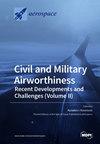Influence of Engine Dynamic Characteristics on Helicopter Handling Quality in Hover and Low-Speed Forward Flight
IF 2.2
3区 工程技术
Q2 ENGINEERING, AEROSPACE
引用次数: 0
Abstract
This study assesses the influence of engine dynamic characteristics on helicopter handling quality during hover and low-speed forward flight. First, we construct the helicopter–engine coupling model (HECM) based on the power-matching relationship between the engine and the rotor. The impact of the engine is evaluated by comparing HECM with a helicopter model without the engine. To assess the engine’s influence quantitatively, we consider torque response, height response, and collective–yaw coupling characteristics in ADS-33E-PRF handling quality criteria. The results reveal that the engine power output lag can deteriorate the helicopter’s torque and height response handling quality rate (HQR). After the increase in helicopter mass, the torque HQR caused by engine influence improved, and the altitude HQR further deteriorated. The engine dynamic characteristics can also reverse the yaw rate, decreasing collective–yaw coupling HQR. As the helicopter’s flight speed increased, the engine’s impact on the yaw rate increased by 41.8%. This study can provide valuable insight into the effects of engine dynamic characteristics on helicopter handling quality and offer a reference for the design of helicopter–engine coupling control laws.发动机动态特性对直升机悬停和低速前飞操控质量的影响
本研究评估了悬停和低速前飞期间发动机动态特性对直升机操控质量的影响。首先,我们根据发动机和旋翼之间的动力匹配关系构建了直升机-发动机耦合模型(HECM)。通过将 HECM 与不带发动机的直升机模型进行比较,评估了发动机的影响。为了定量评估发动机的影响,我们考虑了 ADS-33E-PRF 操控质量标准中的扭矩响应、高度响应和集体偏航耦合特性。结果表明,发动机功率输出滞后会降低直升机的扭矩响应和高度响应操控质量率(HQR)。直升机质量增加后,发动机影响导致的扭矩 HQR 有所改善,而高度 HQR 则进一步恶化。发动机的动态特性还能使偏航率反转,降低集体-偏航耦合 HQR。随着直升机飞行速度的增加,发动机对偏航率的影响增加了 41.8%。本研究可为了解发动机动态特性对直升机操控质量的影响提供有价值的见解,并为直升机-发动机耦合控制规律的设计提供参考。
本文章由计算机程序翻译,如有差异,请以英文原文为准。
求助全文
约1分钟内获得全文
求助全文
来源期刊

Aerospace
ENGINEERING, AEROSPACE-
CiteScore
3.40
自引率
23.10%
发文量
661
审稿时长
6 weeks
期刊介绍:
Aerospace is a multidisciplinary science inviting submissions on, but not limited to, the following subject areas: aerodynamics computational fluid dynamics fluid-structure interaction flight mechanics plasmas research instrumentation test facilities environment material science structural analysis thermophysics and heat transfer thermal-structure interaction aeroacoustics optics electromagnetism and radar propulsion power generation and conversion fuels and propellants combustion multidisciplinary design optimization software engineering data analysis signal and image processing artificial intelligence aerospace vehicles'' operation, control and maintenance risk and reliability human factors human-automation interaction airline operations and management air traffic management airport design meteorology space exploration multi-physics interaction.
 求助内容:
求助内容: 应助结果提醒方式:
应助结果提醒方式:


